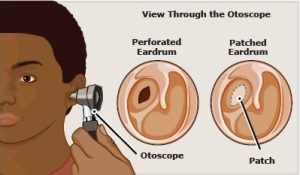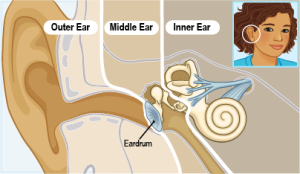What Is a Tympanoplasty?
Tympanoplasty is microsurgery ― surgery using a microscope or endoscope― to fix holes in the eardrum that do not heal on their own. The eardrum, also called the tympanic membrane, enables a person to hear by vibrating in reaction to sound. A small hole may not affect hearing much, but a larger one or one in a particular area of the eardrum may cause hearing problems.
Who might need tympanoplasty surgery?
A tympanoplasty may be needed to repair a perforated eardrum that does not heal on its own. Signs that the eardrum is not healing include persistent hearing loss and drainage from the ear (otorrhea).
Adults or children can get a hole in the eardrum from:
- Head trauma
- Repeated or severe ear infections
- Surgery, such as placement of ear tubes
- Cholesteatoma (skin cyst in the ear)
- Inserting something into the ear canal, such as a cotton swab
- A sudden change in pressure, such as from a wave slapping the eardrum or a blast injury
Because children are more likely than adults to develop ear infections, to receive ear tubes or to insert things in their ears, they are more likely to have eardrum perforation that needs tympanoplasty.
The physician may perform the following to determine if tympanoplasty will help address symptoms:
- Medical history and physical examination
- Examination of the ear using an otoscope and a microscope to visualize the eardrum
- Comprehensive audiometry with age-appropriate hearing tests
- Tympanometry, which is a test to measure the eardrum’s movement when pressured air is directed into the ear canal
- A CT (computerized tomography) scan, especially if a cholesteatoma is suspected
- A questionnaire that helps the doctor understand the impact of the symptoms on the patient’s quality of life.
What Happens Before a Tympanoplasty?
A child/adult will have a hearing test before the surgery. This lets doctors compare the results with hearing tests done after the surgery.
What Happens During Tympanoplasty?
A very simple eardrum repair may be conducted in a doctor’s office with local anesthesia. But for most patients, especially children, tympanoplasty is performed in an operating room with general anesthesia. Patients can usually go home the same day.
Once the patient is asleep under anesthesia:
- The surgeon enters the ear through the ear canal or an incision behind or in front of the ear. The approach depends on the size and location of the hole in the eardrum and if the ossicles are displaced or damaged.
- After locating the hole in the eardrum with a microscope or endoscope, the surgeon removes the edges of the hole and then closes it with a graft, which is a patch of tissue from the patient or a manufactured material. The graft supports growth of new cells and over time closes the hole in the eardrum. The graft may cover just the hole or the entire eardrum.
- The graft is secured to the ear canal (and to other structures, depending on the type of tympanoplasty) with a spongy packing that dissolves over time as the eardrum tissue grows back together and heals. The healing process takes weeks or months.
The duration of the surgery depends on the extent of repairs. Repair of a small eardrum perforation may take only a few minutes, while more complex surgeries that require reconstruction of the ossicles or removal of the mastoid bone may last several hours.

How Long Does a Tympanoplasty Take?
The operation usually takes from 30 minutes to 2 hours.
What Happens After Tympanoplasty?
The surgery team will give you care instructions. For example, you might need to:
- avoid nose-blowing
- sneeze with the mouth open
- avoid getting water in the ear
- use ear drops, if prescribed
For about a week after surgery, you may have:
- mild ear pain that gets better with pain medicine
- a small amount of blood or fluid draining from the ear
- a feeling of fullness in the ear
Usually, any packing placed in the ear will dissolve over time. At the first post-operative visit 2–3 weeks after surgery, the surgeon may try to remove any that is left. You can expect your hearing to improve over 2 or 3 months after the surgery. The surgery team will schedule a repeat hearing test 8–12 weeks after surgery.
Are There Any Risks From Tympanoplasty?
There’s a very small risk of bleeding or infection from a tympanoplasty. Other risks include:
- graft failure
- hearing that doesn’t improve or that gets worse
- ringing in the ear
- funny taste in the mouth
- dizziness
When Should I Call the Doctor?
Call your doctor if:
- You see fresh (bright red) blood on the bandage or packing, or oozing from the ear or incision.
- The ear or incision is more tender, red, or swollen than it was when you left the hospital.
- You have a feverover 100.4°F (38°C).
- Your pain gets worse.


